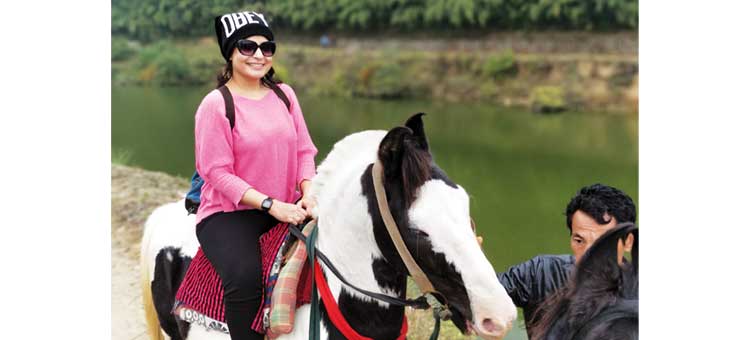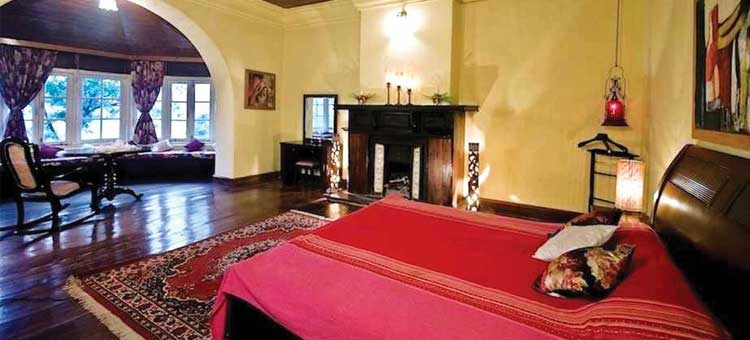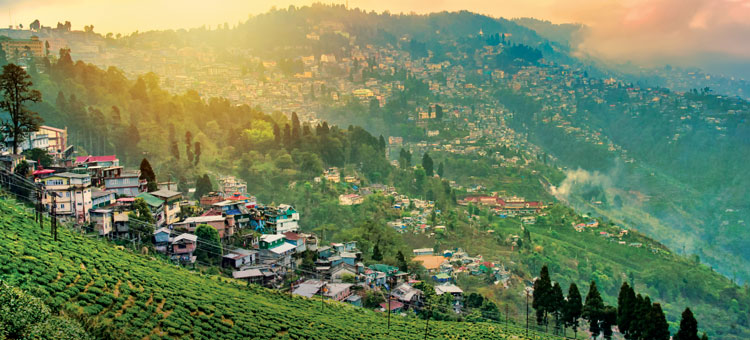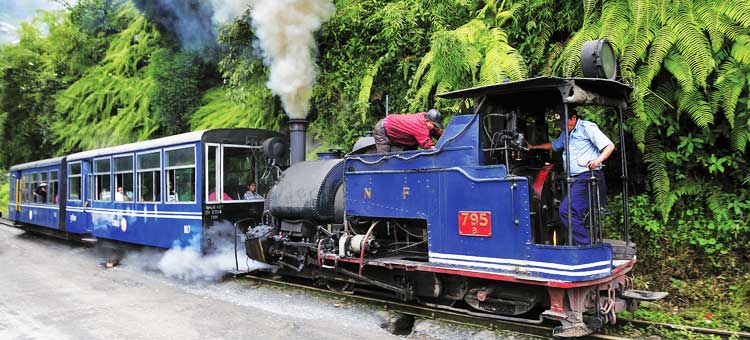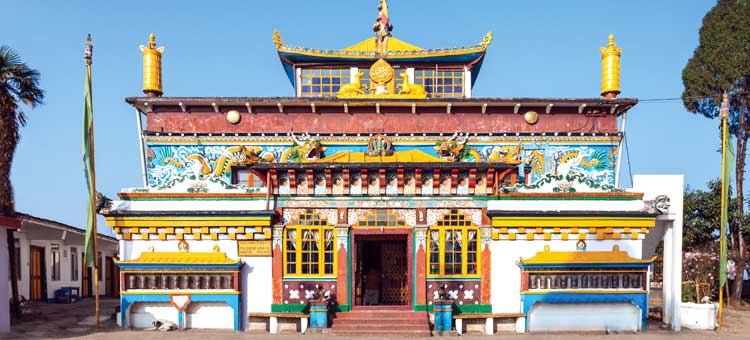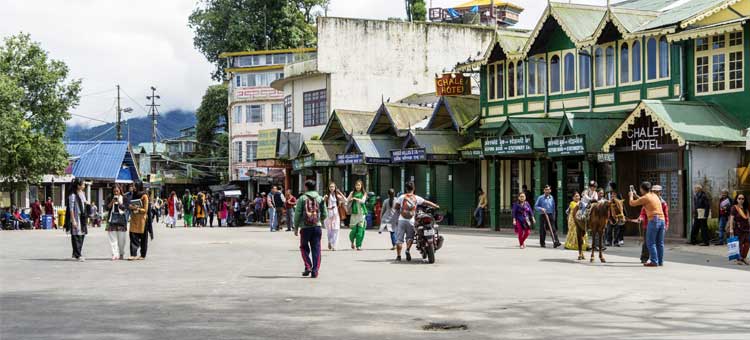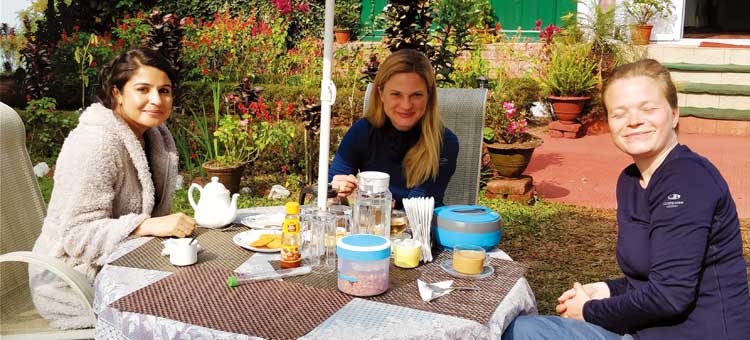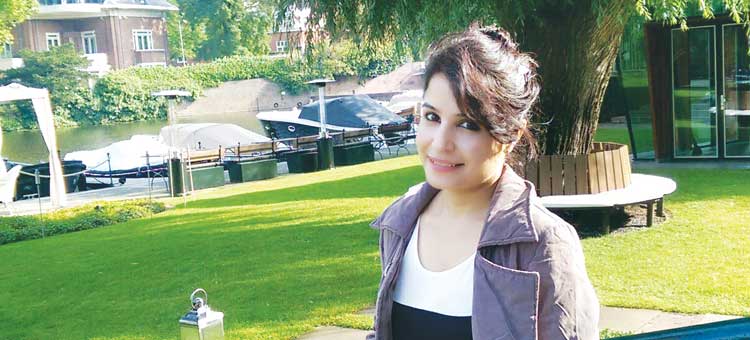Darjeeling: Darjeeling conjures up visions of snow peaks, serenity of vibrant green hills steeped in splendor, a land of breathtaking beauty crowned by the majestic Himalayas. It is one of the most magnificent hill stations in the world. This heavenly retreat is bathed in hues of every shade. Flaming red rhododendrons, sparkling white magnolias, miles of undulating hillsides covered with emerald green tea bushes, the exotic forests of silver fir – all under the blanket of a brilliant azure sky dappled with specks of clouds. No wonder then, Darjeeling undisputedly deserves the sobriquet, ‘Queen of Hill Stations’. The crest of Kanchenjunga shining in the first dawn light truly supports the title.
Darjeeling beckons thousands today for a leisurely respite from the bustle of the maddening crowd. The traveller – whether a tourist or a trekker, an ornithologist or a photographer, a botanist or an artist – will find in Darjeeling an experience which will remain etched in memory – forever.
“I would like to remember my trip to Darjeeling, a heavenly retreat for the bewitchingly beautiful landscape, my adventure ride on the Toy Train, tasting the world’s best tea and meeting some lovely people”
I would like to remember my trip to this heavenly retreat for the bewitchingly beautiful landscape, my adventure ride on the Toy Train, tasting the world’s best tea and meeting some lovely people. After the slump in tourism in 2017 due to political unrest, Darjeeling bounced back in late 2018 registering more than 40 per cent growth. The NRC (National Register of Citizens) related disturbances in Assam contributing in a major way. On an average, 50,000 FTAs and 5,00,000 domestic travelers visit Darjeeling every year. 15-20 per cent of the visitations are during the monsoon months spurred by lower airline and hotel fares in July-August, after the summer rush.
Like most travelers, I clubbed Sikkim with Darjeeling when I planned my vacation last November. October-November is the perfect time of the year to visit as the weather is cold and it is not raining. At the foothills of the Himalayas, Darjeeling stands with pride, as its gateway. Surrounded by emerald green tea plantations and towering Kanchenjunga mountain ranges, it is the most sought after hill station of India.
To reach Darjeeling one can either take a train or flight. The nearest airport is Siliguri (Bagdogra International Airport) and the major railway station is New Jalpaiguri (NJP). It takes about three hours to reach Darjeeling from both places and private taxis are available. One can also take the fascinating Toy Train from NJP or Siliguri all the way up to Darjeeling soaking in the scenic sights of the Himalayas in a 7-hour lazy journey.
Since I was longing for a peaceful vacation amidst the tea gardens, I booked my stay at Singtom Tea Estate & Resorts built in 1862 and regarded as the world’s oldest tea resort. It is just 20 minutes from Darjeeling town.
My flight from Mumbai landed at around noon and the taxi from Singtom was already waiting for me. I reached Darjeeling at five in the evening. It is important to note that the sun sets very early here and by the time I arrived at the resort, it was as dark as it gets around 9 pm.
Singtom is surreal – wake up to spectacular views of Mt. Everest and Mt. Kanchenjunga; walk all day through 1600 acres of tea gardens; enjoy the comforts of an extra spacious 600 sq. ft. room with 160-year old fire place; and a lot more.
Started by Joachim Stoelke, a German priest, in 1854, Singtom Tea Estate is Darjeeling’s second oldest tea estate. Stoelke also planted Darjeeling’s first tea estate, called Steinthal Tea Estate, in 1852. He was fondly known as ‘Father Steinthal’ as a result of his contributions. Father Steinthal discovered that the forests in the Singtom area were an abode of lions, and used to make the short hike from Darjeeling to Singtom to spot lions. When he planted the first tea bushes at Singtom, the locals named the area ‘Singtam’, which meant the house of lions in the local language. Father Steinthal’s co-ownership of both estates led to Singtom and Steinthal being considered sister tea estates. The two estates are right next to each other, with Darjeeling town in between. Father Steinthal planted the two estates in their current locations because he loved the majestic view of the Kanchenjunga mountain range (of course, the mountains were named much later, but they looked breathtaking nonetheless) from both areas!
From 1854 onwards, the estate’s ownership changed hands several times, but has now been with Mohan Chirimar and family, one of India’s oldest tea planting families, for several generations. The Director’s Bungalow built in 1862 was restored by the family and in 2014, Aditya (Mohan’s son) from the 5th generation of Chirimar family rechristened it as Singtom Tea Resort. As a guest staying at their resort, I had unhindered access to the sprawling tea gardens, natural forests, waterfalls and even River Rungneet that flows through the estate.
It was a cold evening in November and hot home cooked vegetarian fare was ready at Singtom. I had my supper early and called it a day. Travelling in hilly areas can be extremely tiresome!
Next morning at six (the sun rises pretty early here) I started my scheduled visit to the tea factory located in the tea estate and at the distance of just 300 m from the resort. It was a tedious uphill walk. Although the distance wasn’t much, the winding road through the gardens is quite steep. Two female travelers from Germany were also staying at the resort and accompanied me. A guide took us around the factory and explained the different stages of processing for making Organic Darjeeling Tea. We saw all three kinds of tea being processed – Black, Green and White. Apparently, white tea is one of the most delicate varieties and said to be rich in antioxidants and associated health benefits. In retail, Darjeeling tea can command a price ranging from
Rs. 500/kg to as high as Rs. 1,00,000/kg.
When we returned to the resort few hours later, breakfast was waiting for us. By now, I had already made friends with the German women. We all had breakfast together and one of the guests from Germany also tried my favorite travel food – Parle-G biscuits – along with tea and found them delicious. I taught her to have it dipped in tea, typical Indian style!
By 11 am, there was a taxi arranged for me and I headed to Mirik, a tourist destination, 45 km from Darjeeling. They say ‘sometimes the journey is more beautiful than the destination’. I could certainly say that for Mirik. If you are visiting Darjeeling, you can never skip Mirik. The drive from Darjeeling to Mirik is one of the best you can have in this region. The way through the forests of pine and oak trees and lovely mountain landscapes covered with clouds is simply breathtaking.
Mirik Lake is about 1.25 km long and at the backdrop of the lake, one can get an idyllic view of Mt. Kanchenjunga and the green luster of oak, chestnut, and maple. I sat, relaxed and enjoyed the beauty of the lake and surroundings. Boating and horse riding are paid adventures worth exploring. I tried my hands at horse riding. Like any other tourist place in India, you should negotiate hard.
There are plenty of quick options like momos, sandwiches, egg rolls and ‘Maggie’ to satiate your hunger. I had vegetable Maggie. Hot spicy Maggie in the cold weather is an altogether different experience, even if you are a regular consumer of the noodle brand back home. All along the roadside, there are numerous small villagers selling organic vegetable. I bought carrots and they were bright orange in color!
On my way back, we dropped by at Simana View Point. Situated at an altitude of 7500 feet, it is a small plateau which offers breathtaking views of the surrounding plains, snow-capped peaks of Mt. Kanchenjunga and the tiny hamlets of Nepal. It was extremely cold and windy so I did not stay too long. Before leaving, I had tapriki chai (tea) here, and proceeded to the famous Pashupati Market on the India-Nepal border.
The main market is about 1 km from the Nepal border. You can either walk or take a Nepal taxi at the border to reach the main market (Rs. 200 for round trip). Alternatively, you can take your own vehicle, complete a vehicle permit formality (national ID proof is must) at the border check post and pay the permit fee (~ Rs. 350 for a vehicle). The market is the perfect place to shop for souvenirs, electronic gadgets, jackets, blankets, perfumes & cosmetics and accessories. By the time I came back to the resort, it was already dark. I had dinner and once in my room cozied up to the fire place before dozing off.
Next morning, we had breakfast outside amidst the tea gardens. Our host had arranged for a beautiful table set up outdoor facing the Kanchenjunga mountains. This location is called 360 Point. It gives visitors a 360-degree view of all the natural beauty that surrounds the resort. One can see more than 60 Himalayan peaks, the undulating hills of Nepal, the Darjeeling town, vast valleys, several tea factories, waterfalls, and a variety of flora and fauna from this spot.
I also tried my hand at tea plucking. For Rs. 500, you can learn and practice the beautiful art of tea plucking. At some plantations, guests are allowed to dress up like the workers and pluck tea!
While in Darjeeling, a ride on the Darjeeling Himalayan Railway (DHR) or the Toy Train is a must do, so the rest of my day was allocated towards that. DHR was opened in 1881 and is now a UNESCO® World Heritage Site. Travelers must buy the Toy Train tickets in advance as the tickets usually get sold out during peak season. The best way is to book online through the Indian Railways website www.irctc.co.in. Tickets are also available at Darjeeling station.
It’s a 2-hour round trip from Darjeeling up to Ghum, India’s highest railway station, and back, covering a distance of 14 km. The train stops for 10 minutes at the Batasia Loop which is another tourist point in Darjeeling. The Batasia Loop is a spiral railway created to lower the gradient of ascent of the DHR. At this point, the track spirals around over itself through a tunnel and over a hilltop.
There are multiple rides scheduled starting at 7:30 in the morning till evening with the last ride beginning at 4:20 pm. The services engage steam or diesel powered engines and the former is more expensive than the latter. The ticket for diesel engine ride is for Rs. 800 and steam engine Rs. 1400.
It was great to experience one of the engineering marvels where many amazing loops and zig zags had to be created to negotiate the steep gradients in the mountains. The breathtaking view of the Himalayas on this journey is spellbinding. Several films have depicted the heritage railway. The hit song ‘Mere Sapno Ki Rani’ featuring Sharmila Tagore and Rajesh Khanna in the 1969 film Aradhana is most famous so is a more recent blockbuster titled Barfi!, both of which feature the DHR.
After the joy ride, I walked through the streets of Darjeeling, had dinner and headed back to the resort.
In July this year, UNESCO® shot off a strongly worded letter to DHR accusing it of poor upkeep and threatening to revoke the heritage tag. Indian Railways has blamed frequent landslides and non-cooperation of local people staying close to the tracks as the reasons for failing to maintain the Toy Train.
Next morning at around 3:30, I left for Tiger Hill, at 8500 ft. the highest point in Darjeeling, to experience the mystic sunrise. Sun rises at around 4:15-4:30 am and depending on the season. Tiger Hill is most famous for its splendid sights of sunrise from where you can see the peaks of Everest, Kanchenjunga, Lhotse and Makalu (four of the world’s five highest peaks) as well as mountains spanning four countries (Nepal, India, China, Bhutan), illuminate before the sun is seen at lower elevations. The magnificent view of snow-covered mountains sitting amidst cotton clouds attracts tourists to Tiger Hill from all over the country.
Remember, Darjeeling’s weather can change anytime without notice. The fog and the mist play a mystical game here all the time. Luckily, the sky was clear and I could experience the awesome view of sun striking the mountains. After returning to the resort, I had my breakfast and checked out. For at least a day during my trip, I wanted to stay in the heart of Darjeeling town at Mall Road to be close to all the activities, restaurants and shopping outlets. I found a hotel at Chowrasta. There are many good hotels like the Sinclairs, Ramada by Wyndham, MayFair Darjeeling Resorts and The Elgin in this area.
I checked in, kept my bags inside the room and left to visit the famous Ghoom Monastery. At a grand elevation of 8000 ft., the Yiga Choeling or Old Ghoom Monastery is the oldest Tibetan Buddhist Monastery of Darjeeling. If you are planning to visit the ‘real’ Ghoom Monastery, be specific and mention Old Ghoom Monastery because the local cab drivers also refer to another monastery Samten as Ghoom Monastery! One of the key attractions inside the monastery is the 15-foot statue of Maitreya Buddha and a large collection of Buddhist manuscripts that includes a 108-volume Kangyur – The Tibetan Buddhist Gospel. There are also numerous bells and a huge drum among the exhibits. Unfortunately, photography is not allowed inside the monastery.
Located on the slopes of Jalapahar Hill, the Japanese Peace Pagoda (Shanti Stupa) was established to symbolize unity, harmony and goodwill amongst people. Shanti Stupa showcases the four avatars of Lord Buddha and can be reached by cab or foot though there is a lot of climbing to do if you choose the latter. The view from the top of the Pagoda, the tallest free standing structure in Darjeeling, offering a panorama of Darjeeling landscape including the Kanchenjunga range, is to die for. As you climb up the stairs of the Pagoda, you will see two concrete models of lions on both sides at a lower level. The avatars of Buddha are all large statues carved on the walls and polished in gold color. Take a walk (‘Parikrama’) around the Pagoda at the pinnacle and you will see beautiful artworks etched on sand stone that look like wooden framework depicting the life of Buddha.
Darjeeling suffers from over-tourism as bulk of the visitors arrive during summer. The tourism administration needs to promote Darjeeling as a year round destination so that the perils of over-tourism do not destroy this hill station. That is if it has not already. While making hotel bookings, please check with local contacts to ensure that the property you have chosen for stay is not facing a water shortage! There is no denying that tourism receipts are vital to Darjeeling but it should not come at the cost of environmental degradation and scarcity of basic resources which the locals face once tourists return. Greater awareness and sensitivity building, stringent laws and enforcement, and tourist taxes are necessary for Darjeeling to survive.
From Peace Pagoda, I went to Chowrasta (Darjeeling Mall) which is a flat open public square, a ‘pedestrian only’ zone free of vehicular traffic and surrounded by colorful stores with backdrop of mountains and valleys. It is perhaps the best place to roam about leisurely. You can take a stroll, sit on the benches and soak the sun, enjoy the visual treat of the mountains all around or even undertake a pony ride. There are many beautiful boutique stalls around the mall. You will lose track of time with the endless tempting options at The Mall Road. You can buy souvenirs, fancy jewelry items, woollen clothing ranging from shawls, jackets, scarves and sweaters, tea pots, and many other items. The Brabourne Park is attached to the Chowrasta and features a musical fountain. Tibet Art, Nathmulls Tea Store & Sunset Lounge, Life & Leaf (locally produced organic tea & honey), Golden Tips Tea Lounge, Oxford Book & Stationery, Habeeb Mullick & Son (rare collections of artworks, curios, special jewelry and other souvenir items), and Fiesta (café & restaurant) should be on your list.
There are sought after places like Observatory Hill, Barbotey Rock Garden and Ganga Maya Park, Shrubbery Nightingale Park and Darjeeling Ropeway (Darjeeling-Rangit Valley Passenger Cable Car – this was not operating when I visited) which I did not have time to explore, but one can include in their travel plan. Darjeeling is easily a 5-night itinerary as there is so much to enjoy and experience at a slow pace.
In July this year, weather played spoil sport disrupting communication and transportation links and heavy cancellations followed for bookings in August and September resulting in huge losses for the Darjeeling travel trade which is worth Rs. 400 crore. Tourism is one of the mainstays of Darjeeling’s economy. A long term sustainable solution to road development in the hill station is a must for tourism and daily lives to prosper.
WEATHER
Dec-Feb: Very cold, no rain
Mar-Apr: Cool, no rain
Apr-Jun: Warm, no rain
Jul-Sep: Warm, rain
Oct-Nov: Cool, no rain
TREKKING
Trekking in Darjeeling is one experience that no thrill-seeker would want to miss out on. The trek begins in Darjeeling and proceeds through Maneybhanjan, Tonglu, Sandakphu and ends in Phalut. There are trekker huts under the management of Darjeeling Gorkha Hill Council Tourism Department all along the route to Sandakphu. The panoramic view of Mt. Everest and Mt. Kanchenjunga is what makes trekking in Darjeeling an unforgettable experience. There are two major seasons for trekking in Darjeeling, one beginning in March and closing in the first week of June. During this season, adventure on the trekking routes in Darjeeling is combined with occasional showers and a splendid flora show. Another season for trekking begins in October and concludes in November, with trekkers enjoying the aftermath of heavy monsoon and the beginning of harsh winters.
RAFTING
White Water Rafting on the river Teesta and Rangeet (Triveni), the scenic beauty of the banks, surrounding hills, its flora and fauna and sighting of several varieties of fish is simply enchanting. White water rafting is relatively new in Darjeeling but it’s certainly as fun-filled as in any other destination.
BIRD WATCHING
Eastern India is home to more than 850 species of birds and is considered as the richest birding area in the country. The abrupt juxtaposition of many different biotopes or life zones ranging from almost plains level to over 6,000m and from tropical heat to arctic cold, has given to the Eastern Himalayas a flora and fauna that for richness and variety is perhaps unequalled in the world.
HOW TO REACH
Distance from Kolkata to Darjeeling: 656 km
By Air: The nearest airport to Darjeeling is Bagdogra. There are direct flight connections with Delhi, Kolkata, Guwahati and other major cities of India. Tourists heading for Darjeeling can get direct taxis/cabs to Darjeeling from Bagdogra or one can head towards Siliguri first and get a transport there
By Train: Apart from Darjeeling Railway Station, the two closest railway stations are Siliguri and New Jalpaiguri. These railway stations have direct connections with Kolkata, Delhi, Guwahati, Varanasi and other major cities of India
By Road: The major access to Darjeeling by road is via Siliguri, which is connected to all the major cities of India
TRAVEL TIPS
- Take a joy ride on the Toy Train – book for a steam engine service
- Buy and taste Darjeeling Tea
- Travelling within the city is easier in a cab. Agree on a fare before you engage one
- Bargain, bargain and bargain! With local drivers or shop keepers at Mall Road, your bargaining skills will be tested
- You would need to do a lot of walking. Keep a sports or walking shoe ready
- In uphill journey one can experience nausea. It is advisable to have altitude sickness medicines handy
- Warm clothes are a must – especially ear mufflers, scarves and caps
- Unpredictable showers are very common, so have an umbrella with you
- Be an early riser so you have more time on hand to visit the various attractions. The sun sets early in Darjeeling
- Experience spectacular sunrise and spot different peaks using the telescope at Tiger Hill View Tower
- Keep cash with you; not every place accepts credit cards or other forms of electronic money
For more information: www.wbtourismgov.in/destination/details/darjeeling
(The author is a marketing professional based in Mumbai. When not working, she enjoys travelling to offbeat destinations and sharing her experiences)

